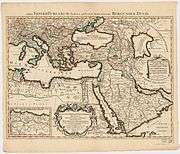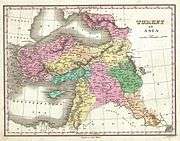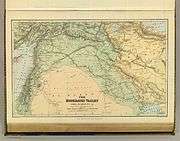Ottoman Iraq
Ottoman Iraq refers to the period of the history of Iraq when the region was ruled by the Ottoman Empire (1534–1704 and 1831–1920).
Before reforms (1534–1704), Iraq was ruled as Baghdad Eyalet.
Ottoman Iraq was later (1831–1920) divided into the three vilayets (provinces):
During World War I, an invasion of the region was undertaken by British Empire forces and was known as the Mesopotamian campaign. Fighting commenced with the Battle of Basra in 1914 and continued for the duration of the war. The most notable action was the Siege of Kut, which resulted in the surrender of the British and British Indian Army garrison of the town in April 1916, after a siege of 147 days. Of the 11,800 Allied soldiers who survived to be made prisoners, 4,250 died of disease or at the hands of their Ottoman guards during captivity.[1]
Contemporary Maps, showing Eyalets (pre Tanzimat reforms)
| Maps of Contemporary Ottoman Iraq showing Eyalets (pre 1864 Vilayet Law) |
|---|
| 1835, showing Eyalets (Bradford) |
|
Contemporary Maps, showing Vilayets (post Tanzimat reforms)
| Maps of Contemporary Ottoman Iraq showing Vilayets (post Tanzimat reforms) |
|---|
|
References
See also

_-_Geographicus_-_RegnumPersicum-ottens-1730.jpg)
%2C_Persia_and_Arabia_-_Geographicus_-_MagniTurcarum-seutter-1740.jpg)

.jpg)

_1803.jpg)



_-_Geographicus_-_TurkeyAsia-m-1849.jpg)

_-_Geographicus_-_Klein-AsienSyrien-stieler-1873.jpg)
.jpg)
